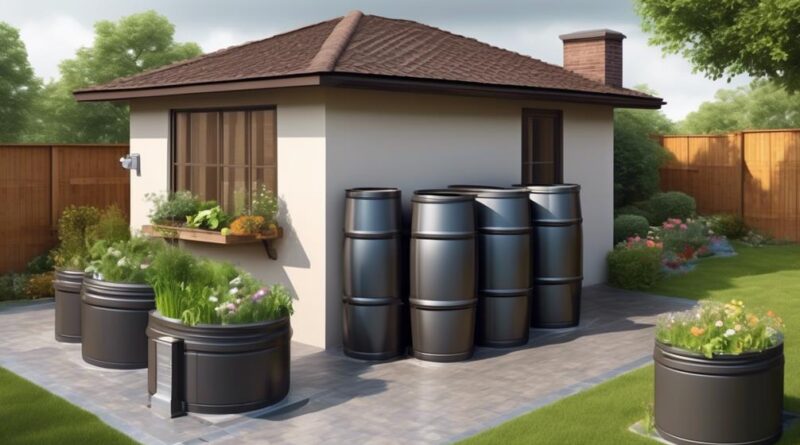What Are the Environmental Benefits of Rainwater Harvesting?
Have you ever considered how something as simple as collecting rainwater can have a significant impact on the environment?
The environmental benefits of rainwater harvesting are numerous, ranging from reducing water demand and minimizing runoff pollution to promoting groundwater recharge and supporting biodiversity.
But that's just the beginning. By embracing rainwater harvesting, you can play a crucial role in addressing pressing environmental challenges and creating a more sustainable future for generations to come.
Reducing Water Demand
To reduce water demand, implementing rainwater harvesting systems is a practical and effective solution for conserving water resources, especially in the context of sustainable landscaping and urban agriculture.
Sustainable landscaping, which involves using environmentally friendly practices to create and maintain healthy, attractive outdoor spaces, can greatly benefit from rainwater harvesting. By capturing and storing rainwater, this approach reduces the need for excessive irrigation, thereby conserving water and promoting sustainable landscaping practices.
In urban agriculture, where space is often limited and water resources can be scarce, rainwater harvesting plays a vital role in addressing water demand. Urban agriculture refers to the practice of cultivating, processing, and distributing food in or around urban areas. By utilizing rainwater harvesting systems, urban agricultural initiatives can become more self-sufficient in terms of water usage, reducing the strain on municipal water supplies and promoting a more sustainable approach to food production in urban environments.
Minimizing Runoff Pollution
Implementing rainwater harvesting systems not only reduces water demand but also plays a crucial role in minimizing runoff pollution, contributing to the overall environmental benefits of this sustainable practice.
In urban development, impervious surfaces such as roads, driveways, and rooftops prevent rainwater from naturally soaking into the ground. Instead, this runoff flows over these surfaces, picking up pollutants like oil, pesticides, and fertilizers, ultimately depositing them into water bodies. Rainwater harvesting helps to address this issue by capturing and storing rainwater, thereby reducing the volume of runoff and the pollutants it carries. By doing so, it assists in effective stormwater management.
Moreover, rainwater harvesting significantly contributes to improving water quality and ecosystem health. The captured rainwater can be used for various non-potable purposes such as irrigation, flushing toilets, and washing clothes, reducing the demand on traditional water sources. As a result, less water is drawn from rivers, lakes, and aquifers, reducing the risk of these sources running dry and maintaining the natural flow of water bodies. This, in turn, helps sustain healthy ecosystems as well as the diverse flora and fauna that rely on these water sources.
Conserving Energy
Conserving energy through rainwater harvesting systems is a key aspect of promoting sustainable practices and reducing environmental impact. By capturing and utilizing rainwater, you can significantly reduce the energy required for pumping and treating water from traditional sources. Rainwater harvesting systems promote energy efficiency by minimizing the need for extensive water treatment processes and reducing reliance on energy-intensive municipal water supplies.
Sustainable practices in rainwater harvesting also extend to the energy saved in transporting water. By using harvested rainwater for non-potable purposes such as irrigation, toilet flushing, and laundry, you can reduce the demand for treated water, which in turn decreases the energy expended in pumping and distributing water through extensive networks of pipes and infrastructure. This reduction in energy consumption contributes to lower greenhouse gas emissions and overall energy conservation.
Furthermore, rainwater harvesting systems promote sustainable practices by reducing reliance on centralized water treatment and distribution systems, which are often energy-intensive. By capturing and using rainwater on-site, you can decrease the energy required to extract, convey, and treat water, leading to a more sustainable and energy-efficient water supply system.
Incorporating rainwater harvesting into your daily practices not only helps to conserve energy but also contributes to overall environmental sustainability. By embracing energy-efficient rainwater harvesting systems, you play a vital role in reducing the environmental impact of traditional water supply and promoting sustainable practices for a greener future.
Promoting Groundwater Recharge
Promoting groundwater recharge aids in replenishing underground water sources, fostering long-term sustainability for both ecosystems and human communities. By actively promoting groundwater recharge, you can directly contribute to the replenishment of underground water reservoirs, ensuring a more reliable water supply for future generations.
- Sustainable agriculture: Implementing rainwater harvesting techniques on agricultural lands can significantly reduce the reliance on groundwater for irrigation. By capturing and storing rainwater, farmers can use this sustainable water source for crop irrigation, thereby reducing the strain on groundwater reserves.
- Urban landscaping: Incorporating rainwater harvesting systems in urban areas can help recharge groundwater by directing rainwater into the soil instead of letting it runoff into storm drains. This not only helps replenish groundwater but also reduces the burden on municipal water supplies for activities such as landscaping and gardening.
- Community engagement: Educating and encouraging communities to adopt rainwater harvesting practices can lead to increased groundwater recharge. By promoting the use of rain barrels or cisterns for collecting rainwater, communities can actively participate in the conservation and replenishment of groundwater resources.
Promoting groundwater recharge through rainwater harvesting not only benefits the environment but also ensures a sustainable water supply for various human activities, including agriculture and urban development. By taking proactive steps to recharge groundwater, you can contribute to the long-term health and resilience of ecosystems and communities.
Mitigating Erosion and Flooding
To further enhance the positive impact of rainwater harvesting on water resources, it's important to address the mitigation of erosion and flooding that can result from ineffective water management practices.
Rainwater harvesting plays a crucial role in soil conservation and watershed management. By capturing and storing rainwater, the pressure on natural water sources is reduced, thereby preventing excessive runoff that can lead to soil erosion. This is particularly important in areas with steep terrains or vulnerable soil conditions.
Additionally, the stored rainwater can be strategically released to irrigate vegetation, which helps in stabilizing soil and preventing erosion.
Furthermore, rainwater harvesting contributes to flood control by reducing the volume of stormwater that flows into rivers and streams. When excessive rainwater is allowed to flow over impervious surfaces, it can lead to flash floods and overwhelm drainage systems. By capturing rainwater and allowing it to percolate into the ground, the risk of flooding is decreased.
Moreover, the practice of rainwater harvesting can aid in land reclamation by replenishing groundwater and restoring moisture to landscapes affected by prolonged droughts. This not only supports the rejuvenation of vegetation but also helps in maintaining the ecological balance of the region.
Supporting Biodiversity
Rainwater harvesting enhances biodiversity by providing essential water sources for various plant and animal species, supporting a thriving ecosystem. This practice plays a crucial role in preserving habitats and restoring ecosystems, which is vital for wildlife conservation and increasing species diversity.
- Habitat preservation: By collecting rainwater, you can create small ponds or wetland areas that serve as vital habitats for insects, amphibians, and birds. These areas provide breeding grounds and shelter for various species, contributing to the overall biodiversity of the region.
- Ecosystem restoration: Utilizing harvested rainwater for irrigation in green spaces and gardens helps in restoring and maintaining diverse plant communities. This, in turn, attracts a wide range of pollinators, such as bees and butterflies, which are essential for the health and diversity of ecosystems.
- Wildlife conservation: Providing a supplemental water source through rainwater harvesting can be a lifeline for wildlife during dry periods, especially in urban areas where natural water sources may be limited. This supports the conservation of local wildlife and helps sustain healthy populations of diverse species.
Decreasing Sewage Overflows

With rainwater harvesting's positive impact on habitat preservation and wildlife conservation, reducing sewage overflows becomes imperative for maintaining the health and diversity of ecosystems and water sources. Rainwater harvesting can play a crucial role in decreasing sewage overflows by effectively managing stormwater and reducing the strain on existing infrastructure.
By capturing and storing rainwater for various uses such as irrigation, toilet flushing, and laundry, rainwater harvesting helps to alleviate the burden on sewage systems during heavy rainfall. This reduces the likelihood of sewage overflows, which can contaminate water sources and harm aquatic life. Additionally, rainwater harvesting lessens the volume of stormwater entering sewage systems, thus decreasing the risk of overflows and backups during intense storms.
Furthermore, implementing rainwater harvesting systems can alleviate pressure on aging sewage infrastructure. By diverting rainwater for non-potable uses, less strain is placed on sewage treatment plants and pipes, prolonging their lifespan and reducing the need for costly repairs and upgrades. This proactive approach to managing stormwater not only decreases the frequency of sewage overflows but also contributes to the overall resilience and sustainability of sewage infrastructure.
Alleviating Strain on Water Resources
By capturing and storing rainwater for various uses, you can alleviate the strain on water resources and contribute to sustainable water management. Rainwater harvesting promotes water conservation and sustainable practices, reducing the demand on traditional water sources. This helps in maintaining ecological balance and supports responsible resource management.
Alleviating Strain on Water Resources
Rainwater harvesting offers several environmental benefits that contribute to alleviating the strain on water resources:
- Reducing Pressure on Water Supply: By utilizing rainwater for activities such as watering gardens, flushing toilets, or washing clothes, you can decrease the reliance on mains water supply. This reduces the overall demand for water from traditional sources, thereby lessening the strain on water resources.
- Mitigating Urban Flooding: Rainwater harvesting systems can help in managing excess rainwater during heavy downpours, reducing the risk of urban flooding. By capturing rainwater and redirecting it for later use, you can prevent overwhelming stormwater systems and alleviate strain on drainage infrastructure.
- Supporting Sustainable Practices: Incorporating rainwater harvesting into everyday practices promotes sustainable water management. This reduces the need for energy-intensive water treatment and distribution, contributing to more responsible resource management and helping to maintain ecological balance.
Implementing rainwater harvesting practices not only benefits the environment but also fosters a more sustainable and responsible approach to water usage.
Frequently Asked Questions
How Does Rainwater Harvesting Impact the Quality of Drinking Water?
Rainwater harvesting improves water quality by reducing strain on public systems and providing cleaner drinking water. It saves money and has a positive economic impact, benefiting public health and the environment.
What Are the Potential Cost Savings Associated With Rainwater Harvesting Systems?
You can experience significant cost benefits with rainwater harvesting systems. An ROI analysis reveals potential savings on water bills, reduced strain on public water supply, and long-term sustainability. It's an environmentally friendly and financially wise choice.
Are There Any Government Incentives or Rebates for Implementing Rainwater Harvesting?
You can take advantage of government incentives and rebates for rainwater harvesting implementation. These financial benefits can lead to significant cost savings. Check with local authorities and environmental agencies for available programs and support.
Can Rainwater Harvesting Systems Be Integrated Into Existing Building Structures?
Yes, rainwater harvesting systems can be integrated into existing building structures. Structural modifications may be needed, but it's a sustainable option. Consider professional advice for seamless building integration.
What Are the Maintenance Requirements for a Rainwater Harvesting System?
Regular cleaning and system inspection are crucial for rainwater harvesting maintenance. By keeping the system well-maintained, you ensure optimal functionality and prevent issues. It's important to stay on top of these tasks to maximize efficiency.
Conclusion
In conclusion, rainwater harvesting offers numerous environmental benefits such as:
- Reducing water demand
- Minimizing runoff pollution
- Conserving energy
- Promoting groundwater recharge
- Mitigating erosion and flooding
- Supporting biodiversity
- Decreasing sewage overflows
- Alleviating strain on water resources
By implementing rainwater harvesting systems, you can play a part in preserving the environment and ensuring a sustainable future for generations to come.
So, start harvesting rainwater today and make a positive impact on the environment.
